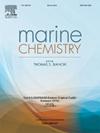地中海西北部DOM多样性和分子组成的季节动态
IF 2.5
3区 地球科学
Q2 CHEMISTRY, MULTIDISCIPLINARY
引用次数: 0
摘要
在地中海,在分层的夏季观测到溶解有机物(DOM)的积累,这与春季浮游植物的最大值脱钩。这通常被解释为营养限制,这阻碍了原核生物对浮游植物释放的不稳定DOM的吸收。然而,夏季相对较高的异养原核生物活性使我们假设积累的DOM可能是顽固性的,来源于这些微生物。为了验证这一点,我们使用FT-ICR MS追踪了2019年至2021年地中海西北部DOM分子组成和化学多样性的季节性,并使用一系列广泛的环境和生物参数对其进行了构建。我们的研究结果揭示了表层混合层DOM分子组成和多样性的明显季节性变化。组分的变化反映出春季含有CHO的分子式比例较高,夏季含有CHOS和CHONS的分子式比例较高。表征DOM顽固性的指标,如芳香性、不饱和度和分子大小在夏季较高,证实了我们的假设,即顽固性DOM在夏季积累。同时,DOM多样性(总分子式数、相对强度、van Krevelen空间平均距离(Dist)和功能多样性)均有所增加,表明夏季DOM的积累可能是溶解初级产物、光降解和原核活性等不同过程相互作用的结果。我们的研究结果可能对通过地中海微生物碳泵进行碳固存具有重要意义,因为这种积聚在表层的DOM一旦出口到深层就可能被储存起来。本文章由计算机程序翻译,如有差异,请以英文原文为准。

Seasonal dynamics of DOM diversity and molecular composition in the NW Mediterranean Sea
In the Mediterranean Sea, an accumulation of dissolved organic matter (DOM) is observed during the stratified summer period, which is decoupled from the spring phytoplankton maxima. This has been classically explained by nutrient limitation, that hampers prokaryotic DOM uptake of the labile DOM released by phytoplankton. However, relatively high heterotrophic prokaryotic activity in summer led us to hypothesize that the accumulated DOM might be recalcitrant and derived from these microorganisms. To test this, we tracked the seasonality of DOM molecular composition and chemical diversity using FT-ICR MS from 2019 to 2021 in the NW Mediterranean Sea, and framed it using a broad suite of environmental and biological parameters. Our results reveal a clear seasonal variation in DOM molecular composition and diversity in the surface mixed layer. Changes in composition reflected a higher proportion of molecular formulae containing CHO in spring and a higher proportion of molecular formulae containing CHOS and CHONS in summer. Proxies of DOM recalcitrance, such as aromaticity, unsaturation, and molecular size, were higher in summer, confirming our hypothesis of an accumulation of recalcitrant DOM in summer. In parallel, an increase in DOM diversity (as number of total molecular formulae, their relative intensity, their average distance (Dist) in the van Krevelen space and their functional diversity) was observed, suggesting that the accumulated DOM in summer is likely the result of the interplay between different processes including dissolved primary production, photodegradation and prokaryotic activity. Our results may have significant implications for carbon sequestration through the microbial carbon pump in the Mediterranean Sea as this DOM accumulated in the surface is likely to be stored once exported into deep layers.
求助全文
通过发布文献求助,成功后即可免费获取论文全文。
去求助
来源期刊

Marine Chemistry
化学-海洋学
CiteScore
6.00
自引率
3.30%
发文量
70
审稿时长
4.5 months
期刊介绍:
Marine Chemistry is an international medium for the publication of original studies and occasional reviews in the field of chemistry in the marine environment, with emphasis on the dynamic approach. The journal endeavours to cover all aspects, from chemical processes to theoretical and experimental work, and, by providing a central channel of communication, to speed the flow of information in this relatively new and rapidly expanding discipline.
 求助内容:
求助内容: 应助结果提醒方式:
应助结果提醒方式:


